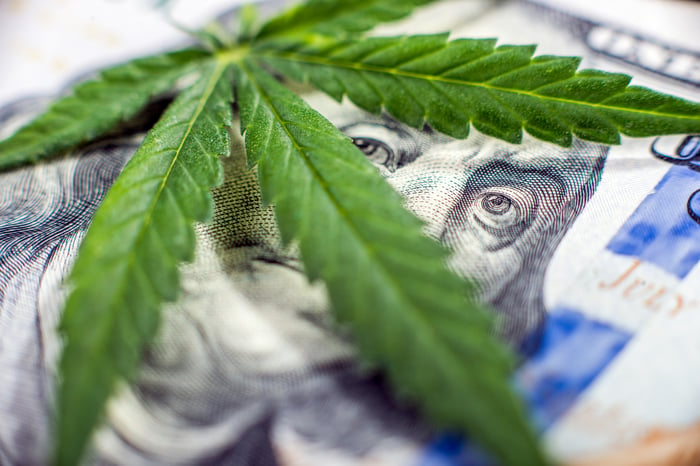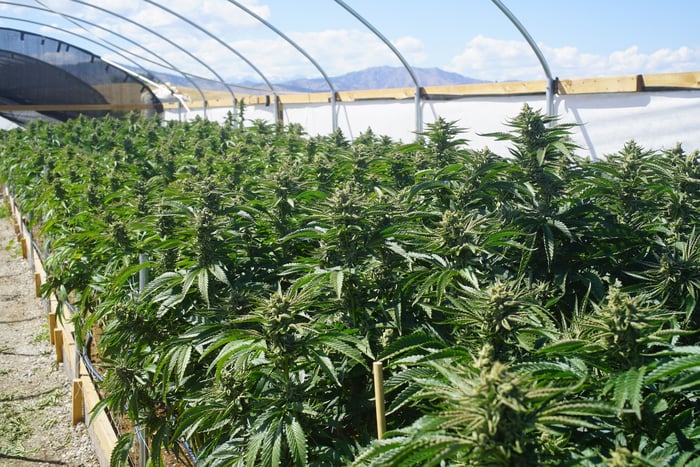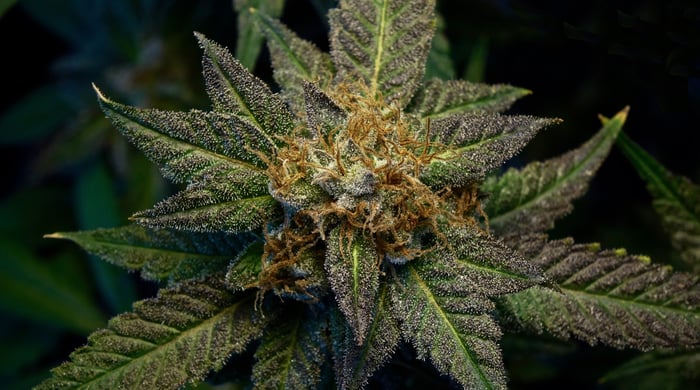Generally speaking, penny stocks -- publicly traded companies with a low share price, usually below $5 -- are bad news. Stocks that have very low share prices are typically low for very good reasons. This might include uncertainty about staying solvent, persistent losses, or operating in a highly competitive or unproven industry. The point being that while penny stock pops do amaze from time to time, penny stocks are, far more often than not, money losers for investors.
These cannabis penny stocks are worth a closer look
But there may be an exception to this rule in the cannabis industry. Although there is no shortage of marijuana penny stocks whose balance sheets and operating results are a disaster, there are three bona fide cannabis penny stocks that could be the real deal.

Image source: Getty Images.
Because pot stocks haven't had much access to nondilutive forms of financing from banks, pretty much all publicly traded weed-focused companies have turned to share offerings or convertible debentures in order to raise cash. Though successful in their capital-raising ventures, these share offerings dilute the value of existing shareholders and weigh on a company's share price. In some instances, pot stocks with respectable market caps north of $300 million aren't even able to muster a $1 share price. Thus, when examining pot stocks, share price isn't all that important. That's what makes the following three marijuana penny stocks potentially attractive investments.
Aleafia Health
Currently boasting a share price of $1 on the nose, Aleafia Health (ALEAF 10.22%) meets every definition of a penny stock. But with a market cap of roughly $280 million and developing cultivation assets that'll make it a major Canadian player, this isn't your typical penny stock.
In March, Aleafia Health completed an all-stock acquisition of Emblem, combining two of Canada's medical-clinic service providers that also happen to grow their own weed. Upon completion of the merger, Aleafia and Emblem had 40 clinics that had served about 60,000 patients since their inception. More importantly, of the three cultivation assets being developed, the new Aleafia foresees 138,000 kilos of peak annual output. Though the production space remains highly fluid, this should be enough to keep Aleafia among the top 10 pot producers in Canada.

Image source: Getty Images.
On one hand, this is an exceptionally intriguing business model. If Aleafia Health can bring in medical patients through its clinic network, it has a very good chance to also sell them in-house-developed cannabis products. Not to mention that medical patients are far more likely to use cannabis, as well as purchase high-margin derivative products such as oils.
On the other hand, Aleafia is an unproven grower, and it will, therefore, need to show Wall Street that it can build up its brands and secure domestic and international supply deals, because it's not going to be able to move 138,000 kilos a year domestically to medical pot patients. Aleafia is also in need of additional capital to execute on its long-term strategy, as evidenced by the 35 million Canadian dollar convertible note offering announced last week. These capital raises remain dilutive to existing shareholders.
While the ride could be bumpy, Aleafia Health offers intrigue.
Auxly Cannabis Group
An even tinier tot than Aleafia Health, at least in terms of share price, is Auxly Cannabis Group (CBWTF 2.43%). But don't let its $0.59 share price fool you -- this company is worth more than $350 million, but obviously has a lot of shares outstanding.
Auxly Cannabis is a blending of two worlds. Until about the midpoint of last year, it was predominantly a licensing company that provided up-front capital to growers looking to expand or develop greenhouses. In exchange, it's to receive a percentage of production at a below-market cost, thereby allowing it to turn around and sell this marijuana at average retail prices and pocket the difference as profit. This method sounds great on paper, but it didn't allow Auxly to substantially lower its costs if the per-gram price of dried flower declines. That's why Auxly Cannabis is now also involved in joint ventures and growing its own marijuana, too.

Image source: Getty Images.
When fully operational, the company aims to retail the equivalent of 170,000 kilos per year. This includes what it'll receive from its more than one dozen licensed partners, as well as from its various joint ventures and wholly owned grow farms. This places Auxly just outside the top five in Canada in terms of how much cannabis will be sold per year (however, don't mistake the fact that Auxly isn't producing 170,000 kilos a year). That makes it a pretty important player that can move the weed market.
The issue is that investing in Auxly will require immense patience. That's because most of its licensed partners won't have their production on line until later in 2019 or sometime in 2020. As a result, Auxly is recognizing very little revenue and has had to turn to share offerings to raise capital to offset losses.
Furthermore, the company aims to focus on the derivative market, meaning it's been holding back dried cannabis flower for processing until Health Canada legalizes additional consumption option in October. While this is a smart long-term move, it'll mean addition pain in the short term by reducing the company's sales potential. Like Aleafia, Auxly Cannabis Group is exciting, but it does come with risks.
The Supreme Cannabis Company
A final marijuana penny stock that's worth your time is The Supreme Cannabis Company (SPRWF). This Ontario-based pot grower sports a share price of right around $1.20, but has a market cap that's virtually identical to Auxly Cannabis Group.
Whereas Aleafia Health and Auxly Cannabis are expected to be major producers and/or retailers of weed, Supreme Cannabis is considered more of a mid-tier producer, with its 7ACRES facility on track for roughly 50,000 kilos of output per year. What makes this output so impressive is that the company will be focused on producing premium and ultra-premium quality marijuana. While the markets for discount and average-quality cannabis are highly competitive, there's very little projected competition among ultra-premium pot. This should lead to little fears of oversupply and strong pricing power for those few growers that are focused on high-quality cannabis.

Image source: Getty Images.
In addition to using genetics to produce premium pot, Supreme Cannabis' 7ACRES facility is also expected to be one of the top-yielding facilities in the industry. As of mid-May, total flowering space was increased to 230,000 square feet, with an annual run-rate yield of 33,580 kilos. That works out to 146 grams per square foot, or more than 45% above the expected industry average.
Furthermore, ultra-premium cannabis buyers tend not to be influenced by traditional cannabis culture. This makes them less susceptible to downturns in the economy, which should lead to more consistent cash flow for Supreme Cannabis.
The concern with Supreme Cannabis, as with Aleafia and Auxly, is that profitability is still a ways off. Wall Street forecasts that the company will be profitable in 2020, although the magnitude of that profit has been falling for months. In other words, it could take some time before Supreme Cannabis proves to investors that it's profitable on a recurring basis.
There may also be concerns about domestic and international supply deals. Nabbing supply deals isn't nearly as important for premium growers as discount or average-quality pot growers, but it likely still has Wall Street on edge.
Nevertheless, Supreme Cannabis looks to have a game plan in place to hold true to its name and be a "supreme cannabis pick" for investors.





